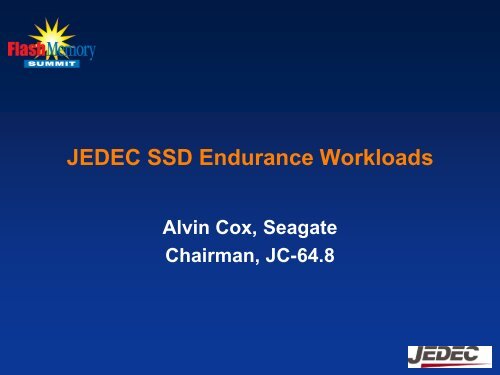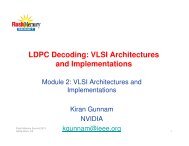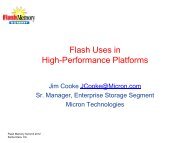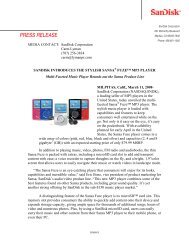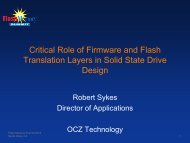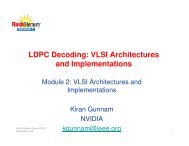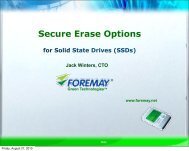Endurance Workloads - Flash Memory Summit
Endurance Workloads - Flash Memory Summit
Endurance Workloads - Flash Memory Summit
Create successful ePaper yourself
Turn your PDF publications into a flip-book with our unique Google optimized e-Paper software.
JEDEC SSD <strong>Endurance</strong> <strong>Workloads</strong><br />
Alvin Cox, Seagate<br />
Chairman, JC-64.8
<strong>Workloads</strong> & SSD Applications<br />
<strong>Endurance</strong> is dependent on the applications being run and<br />
the workloads presented to an SSD<br />
Client SSD<br />
• 8/7 operation, bursty workload<br />
(considerable relaxation times)<br />
• Modest write activity<br />
• More localized access footprint,<br />
smaller than entire LBA space<br />
• Optimized cost<br />
Enterprise SSD<br />
• 24/7 operation, continuous<br />
workload<br />
• Heavy write activity<br />
• Mostly random accesses<br />
across the entire LBA space<br />
• Highest data reliability,<br />
availability, and integrity<br />
<strong>Endurance</strong> ratings must reflect the expected use cases.<br />
JEDEC workloads and testing are targeted at achieving this
JEDEC SSD Standards<br />
JESD218A: Solid State Drive (SSD) Requirements<br />
and <strong>Endurance</strong> Test Method<br />
• SSD Definitions<br />
• SSD Capacity<br />
• Application Classes<br />
• <strong>Endurance</strong> Rating<br />
• <strong>Endurance</strong> Verification<br />
JESD219: Solid State Drive (SSD)<br />
<strong>Endurance</strong> <strong>Workloads</strong><br />
• Client<br />
• Enterprise
<strong>Endurance</strong> Rating (TBW Rating)<br />
• Establishes a rating system for comparing SSDs<br />
• Provides ratings based on application class<br />
• Rating for user-measurable interface activity<br />
This rating is referred to as TBW. Requirements for UBER,<br />
FFR, and retention are defined for each application class.
<strong>Endurance</strong> Rating (TBW Rating)<br />
The SSD manufacturer shall establish an endurance rating for<br />
an SSD that represents the maximum number of terabytes that<br />
may be written by a host to the SSD, using the workload<br />
specified for the application class, such that the following<br />
conditions are satisfied:<br />
1) The SSD maintains its capacity<br />
2) The SSD maintains the required UBER for its application class<br />
3) The SSD meets the required functional failure requirement (FFR) for its<br />
application class<br />
4) The SSD retains data with power off for the required time for its<br />
application class<br />
From JESD218A, Copyright JEDEC. Reproduced with permission by JEDEC
Application Classes & Attributes<br />
Application<br />
Class<br />
• Client<br />
• Enterprise<br />
Application<br />
Class Attributes<br />
• Workload<br />
• Daily Active Use<br />
• Data Retention<br />
• BER
Application<br />
Class<br />
SSD <strong>Endurance</strong> Classes And Requirements<br />
Workload Active Use<br />
(power on)<br />
Client Client 40 o C<br />
8 hrs/day<br />
Enterprise Enterprise 55 o C<br />
24hrs/day<br />
Retention<br />
Use<br />
(power off)<br />
30 o C<br />
1 year<br />
40 o C<br />
3 months<br />
Functional<br />
Failure<br />
Rqmt (FFR)<br />
UBER<br />
3% 10 -15<br />
3% 10 -16<br />
From JESD218A, Copyright JEDEC. Reproduced with permission by JEDEC
Key To <strong>Endurance</strong> For NAND<br />
Program/erase (P/E) cycles<br />
• The writing of data to one or more pages<br />
in an erase block and the erasure of that<br />
block, in either order.<br />
• NAND has a limit on how many P/E<br />
cycles it can withstand until data retention<br />
is not reliable. UBER and data retention<br />
are adversely affected by P/E cycles.<br />
Program Erase
DATA Retention<br />
UBER (Unrecoverable Bit Error Ratio)<br />
• UBER could be considered a short-term data<br />
retention measure although it is measured over<br />
the life of the SSD<br />
Retention failure<br />
• A data error occurring when the SSD is read after<br />
an extended period of time following the previous<br />
write. This can be considered a long-term data<br />
retention measure
WAF – A Key <strong>Endurance</strong> Factor<br />
The higher the WAF, the faster the <strong>Flash</strong> wears out<br />
• Write Amplification Factor (WAF)<br />
• The amount of data written to the NVM divided by the amount of data written<br />
by the host to the SSD<br />
• WAF is directly associated with P/E cycles<br />
• Higher WAF = More P/E cycles happen<br />
• An SSD usually writes more data to the memory than it is<br />
asked by the host to write<br />
• The nature of the workload has a significant impact on WAF
Workload Impact On WAF<br />
Workload factors that impact WAF:<br />
• Sequential versus random<br />
• Large transfers versus small transfers<br />
• Boundary alignment<br />
– Transfer size vs program page<br />
size/alignment<br />
– Transfers crossing erase blocks<br />
• Data content/patterns (especially for SSDs<br />
using data compression)
Workload Comparison<br />
Client workload<br />
• Based on actual client trace<br />
• Real trace commands replayed<br />
• Includes trim commands<br />
• Does not touch every user LBA<br />
• Full random data pattern to stress<br />
write amplification factor – required<br />
• Non-random pattern - optional<br />
• Random selection of data from a<br />
confirmed entropy data file<br />
• Reported in addition to full<br />
random results<br />
Enterprise workload<br />
• Similar to SPC1 profile<br />
• Synthetically generated by script<br />
• Does not include TRIM or UNMAP<br />
commands<br />
• Touches every user LBA resulting in<br />
100% full utilization<br />
• Full random data pattern to stress<br />
write amplification factor
Client Workload – JESD219<br />
The client workload consists of the following:<br />
• Precondition phase<br />
– Write all user LBAs<br />
– Testing at 100% full still under discussion<br />
• Run the test trace<br />
– Based on standard ATA I/O commands<br />
– Adjusted to stay within the SSD user capacity<br />
– Includes all commands from a real trace capture<br />
– The trace only has commands, including TRIM<br />
– Data payload is generated separately as random data<br />
• Replay the test trace to verify TBW rating
SPC-1C…<br />
SPC-1C Enterprise Workload<br />
Is a set of I/O operations designed to demonstrate<br />
the performance of a small storage subsystem<br />
while performing the typical functions of a<br />
business critical application<br />
Represents a segment of applications<br />
characterized by predominately random I/O<br />
operations and requiring both queries as well as<br />
update operations<br />
Focuses on small storage solutions 1 to 24 drives<br />
Uses 100% 4K aligned transfers<br />
Database Database<br />
OLTP OLTP<br />
Email Email<br />
SPC-1C<br />
Workload
JESD219 Enterprise Workload<br />
• Adjusted SPC-1C<br />
transfer size distribution<br />
to include 10%
JESD219 Enterprise Workload<br />
Several workload studies show that less than 5%<br />
of the data get >50% of the accesses and 20% of<br />
the data get >80% of the accesses<br />
Distribution:<br />
• SSD under test:<br />
– 50% of accesses to first 5% of user LBA space<br />
– 30% of accesses to next 15% of user LBA space<br />
– 20% of accesses to remainder of user LBA space<br />
• Distribution is offset through the different DUTs.<br />
• Address distribution to simulate application usage<br />
except making contiguous simplifies test apparatus<br />
requirements<br />
– Each segment access are randomized<br />
– Segment accesses are intermixed
<strong>Workloads</strong> And SSD Applications<br />
• Enterprise and Client SSDs have different<br />
design points, application uses and<br />
workloads<br />
• Different endurance rating methods are<br />
required for the for the different use cases<br />
• JESD218A and JESD219 define the<br />
methods to derive a means of comparing<br />
the endurance ratings of devices within<br />
each class of device
Thank You


